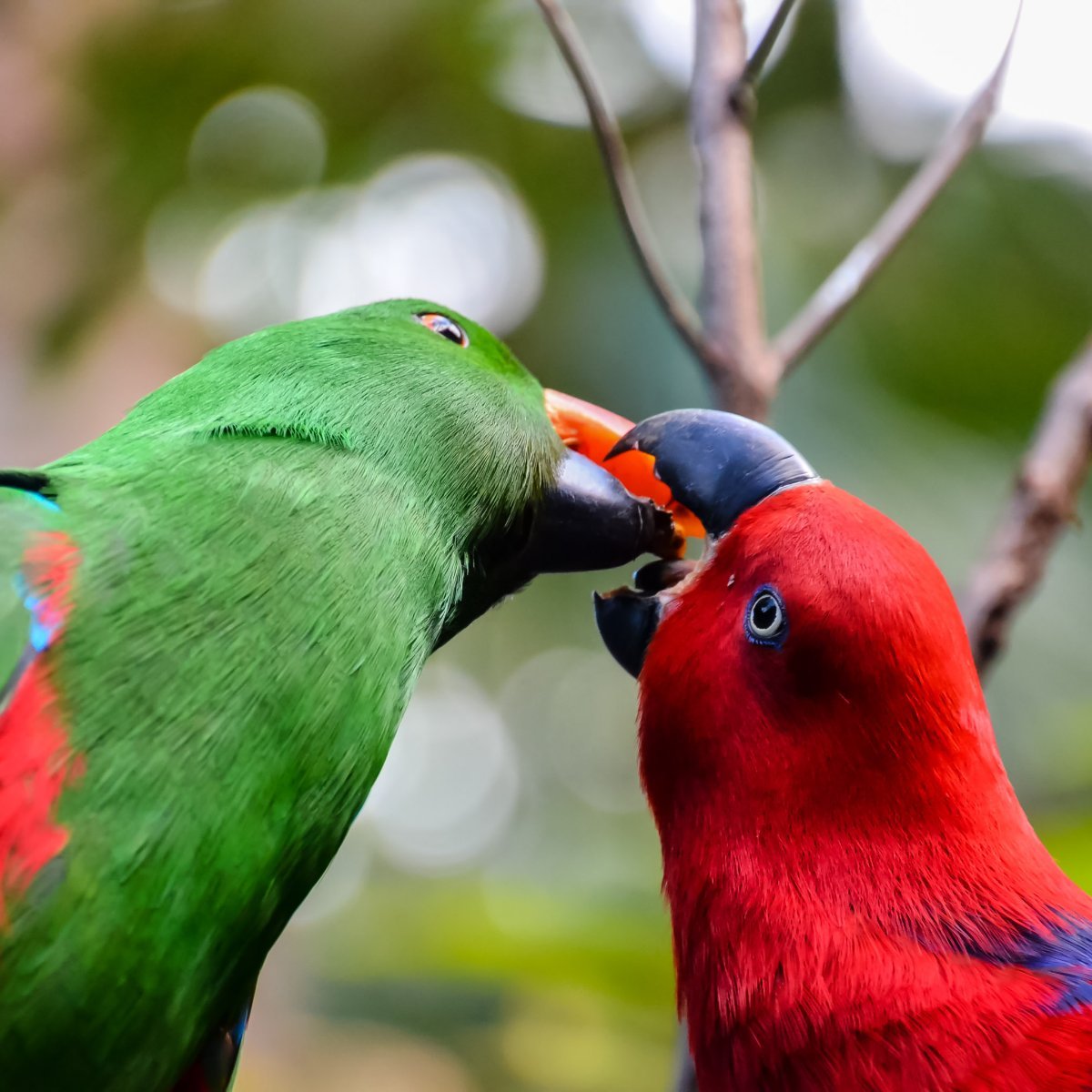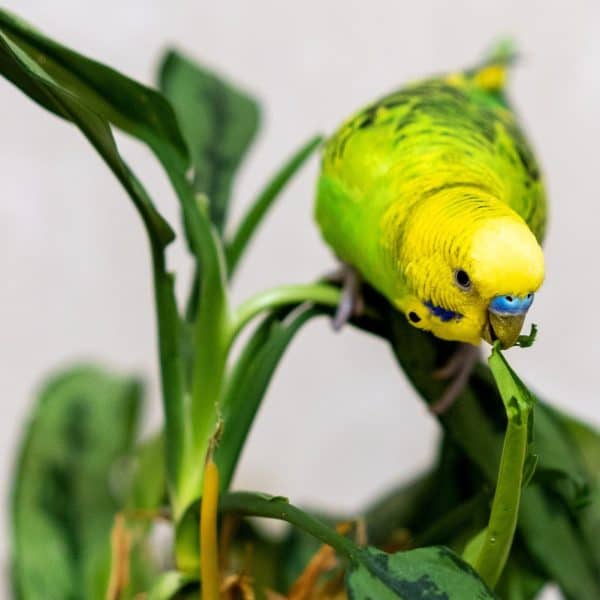
Lets Talk Sex and How Some Birds Give Away Their Sex by Feather Color
Last Updated on by Catherine Tobsing
20% – 25% of parrots are sexually dimorphic meaning you can identify their sex by the color of the bird. Male eclectus are green – females are red.
Male Indian ringnecks have contrasting neck rings that females do not. The ring starts to grow in one feather at a time beginning at about 10 months and completing in 1-1/2 years.
A male budgie commonly has a blue cere but that can vary as well.
It may brighten during the breeding season, and then fade. A female’s cere ranges from white to brown and pink.
Adult budgie hens may have a cere appear crusty and bumpy due to hormones and aging.
Sexing lovebirds
In the video below we see a lovebird shredding precise strips of paper and then tucking them under her wings to carry them to her nest site. This determines it is a female as male lovebirds will just make confetti.
Name: Pam D
I have a Cape parrot that loves to get into my potted houseplants or even the garden in summer (tethered of course) and EAT the dirt, I shoo her away, but wonder if this will harm her.
Also, she loves the dog’s kibbles. I shoo her away from that as well but I’ve heard dog kibble is bad for their liver.
Actually, my dogs are given mostly a raw diet and I supplement a little kibble. I have to put her away until they’re done or she chases them from their food :). Thoughts, please?
Dear Pam
The dirt in your houseplants is more dangerous than the kibble. Please cover the tops of the pots so they cannot eat the dirt.
There can be fertilizers and other toxins in the dirt.
A bit of dog kibble aka pellets will not harm your birds. As with everything else, moderation is the key.
Consider upping your bird’s minerals as they may be suffering from PICA is the persistent eating of substances such as dirt or paint that have no nutritional value., but they may be seeking minerals.
Humans can have the same affliction Hagen Cal-Clay can be useful as a mineral supplement.
Pam replied
I’m not too concerned about Holly getting into the plants b/c she only gets into the one pot occasionally and I chase her away so I know she doesn’t get much dirt, but one has to wonder what too much is.
Covering it is another good precaution.
I have asked on my Facebook parrot groups about this but no one has answered this, so thank you for your quick response – I also wondered about the mineral issue, but my main concern has been about other ‘things’ she might ingest –I will look into the supplements.
The same is true for the kibble – I always chase her away or am sure to put her in her cage while the dogs eat – again thank you for answering at all.
–Just another reason I love Windy City!!
Regards, Pam
MitchR sticking his nose in things
Kibble is in a lot of bird foods just renamed “pellets.”
This situation begs the question what does your bird have to engage with when out of the cage of its own?
Any bird-centric foraging opportunities or toy boxes around the house or garden?
Sherry writes
Lv Sunday Brunch. Helps a lot. Need help with info for egg laying.
Huelo, a greenwing Mccaw, laid 2 eggs 3 years ago.
Now has started laying again and nesting.
Her avian vet. Says take away right after lays. I read about fake eggs when u know she is hormonal. Well, she is hormonal all the time. Do u have a suggestion?? Thank u, Sherry C
Hi Sherry – Here’s what we have found works.
- Remove the eggs – no fake eggs
- Take any nesting material/sleeping huts out of her cage
- Keep minimal amounts of food in food dish so she gets the idea there is abundant food to feed babies – no food at night
- Lock her in her cage for 3 days, put a light on top of it and keep it on for 72 hours which breaks the brooding circadian (oscillation) rhythm.
Chatting with Guest
You: hello how can I help?
Visitor: Hello Mitch, need your advice, please
You: sure what can I help with?
Visitor: I just returned home after nearly 2 months at the hospital. My left leg was amputated and I received a liver transplant.
Visitor: Doctors urged me to find a new home for my female Hahn’s McCaw
Visitor: How shall I approach this so she (4 years old) -will be taken care of
Visitor: It hurts me very much to give her away.
You: By not getting rid of the bird – the doctors are flat out wrong and not knowing anything about birds – the last thing you need is the loss of a pet – I have a post for you
Visitor: Ok
You: Why doctors should be prescribing birds
You: please read – had a similar situation with a cancer patient – Birds are like canaries in coal mines for disease and infection
Visitor: Thank you, Mitch. Let me read. I will get in touch later. And by the way, I love your news, the Sunday brunch newsletter. Very well done.
You: thank you for the kind words – if need be I can send a video on how to make a HEPA air filter for $25 that is as effective as a $1000 unit – the doctors are worried about dander and feces particulate which can be all but eliminated – as long as you can take care of the bird and maybe have someone clean the cage you should be fine
Visitor: That’s it for the time being. Thank you so much. I am glad that I found your website 3 years ago. Have a great week ahead of you.
(same) Sherry wrote:
Enjoy ur info. I have a question. Our bird room is on the west side of the house. Gets warm in this room. I have special blinds and blackout curtains.
The thermostat is in another part of the house so doesn’t know the temp in the room is 77.9. Will get hotter this summer.
None of the bird’s free flight. We put in a ceiling fan to circulate the air.
Fan on low. Do I need to be concerned about a draft at night when the door is closed? I can’t find info other than safety and window drafts. Thank u
Hi Sherry
The problem with “drafts” in the summer is that they may lead to over-preening because of “ruffled feathers”
MitchR
I have a cockatoo and 2 parakeets I have noticed a lot of moths flying around the house. I have noticed a weevil that looks like a maggot on the wall. Can you tell me a bug spray that can use that won’t kill my birds? Thank you, Lu
Email: [email protected]
Name: Lulabelle L
Dear Lulabelle
Moth Traps will take care of the moths and larvae
Poop Off For safe daily cleaning
I hope this helps.
Curated by Mitch Rezman
Approved by Catherine Tobsing
Author Profile
Latest entries
 The Traveling BirdJune 26, 2025Can You Name 5 Parrot Species That Are Living Wild in the USA?
The Traveling BirdJune 26, 2025Can You Name 5 Parrot Species That Are Living Wild in the USA? Bird BehaviorJune 26, 2025How is it Parrots Are Problem Solvers Social Animals and Even Use Tools?
Bird BehaviorJune 26, 2025How is it Parrots Are Problem Solvers Social Animals and Even Use Tools? Bird & Parrot AnatomyJune 25, 2025How a Tiny Chemical Modification Makes Parrots Nature’s Living Paintings
Bird & Parrot AnatomyJune 25, 2025How a Tiny Chemical Modification Makes Parrots Nature’s Living Paintings PigeonsJune 20, 2025How Do Parrots Thrive in Cities Outside Their Native Habitats?
PigeonsJune 20, 2025How Do Parrots Thrive in Cities Outside Their Native Habitats?


